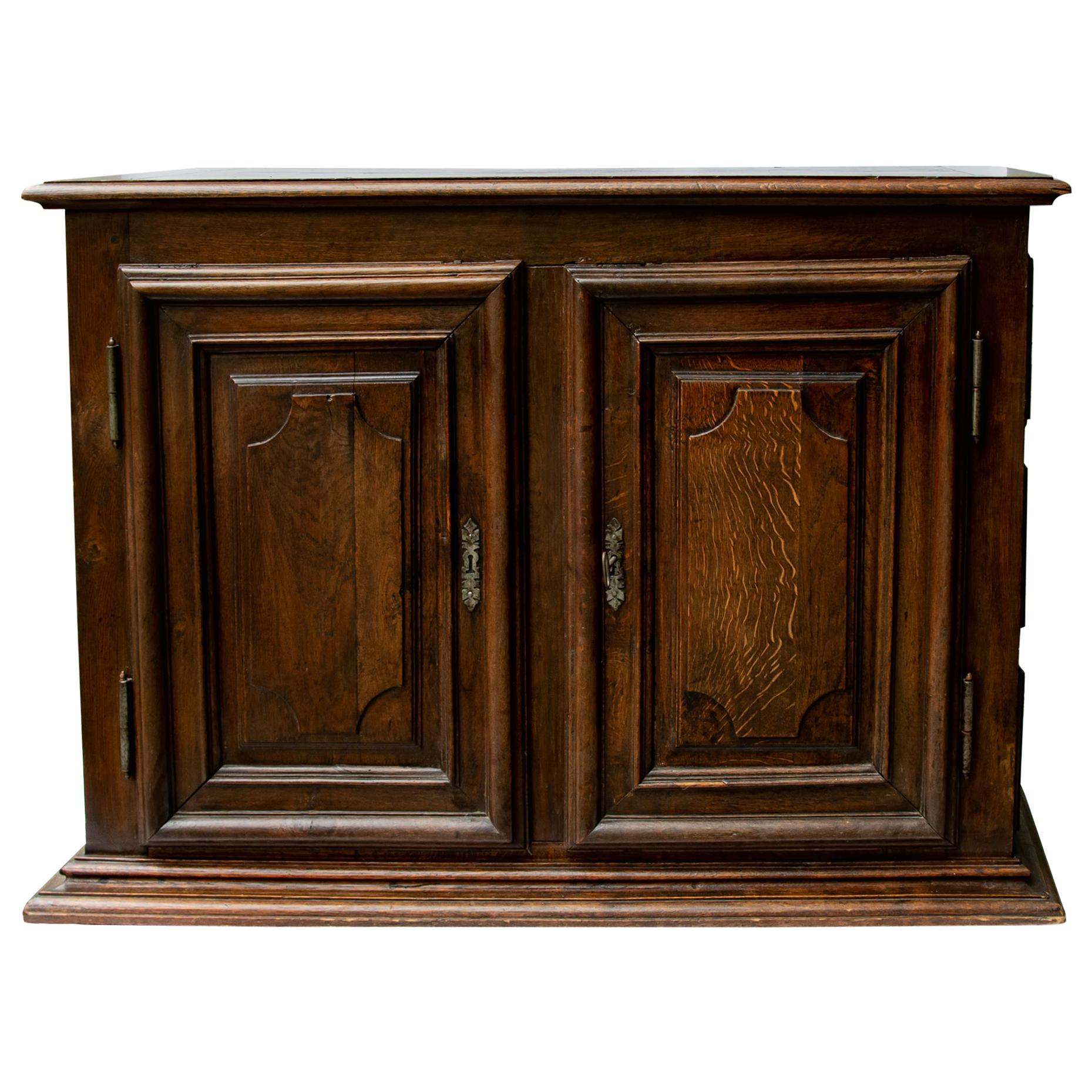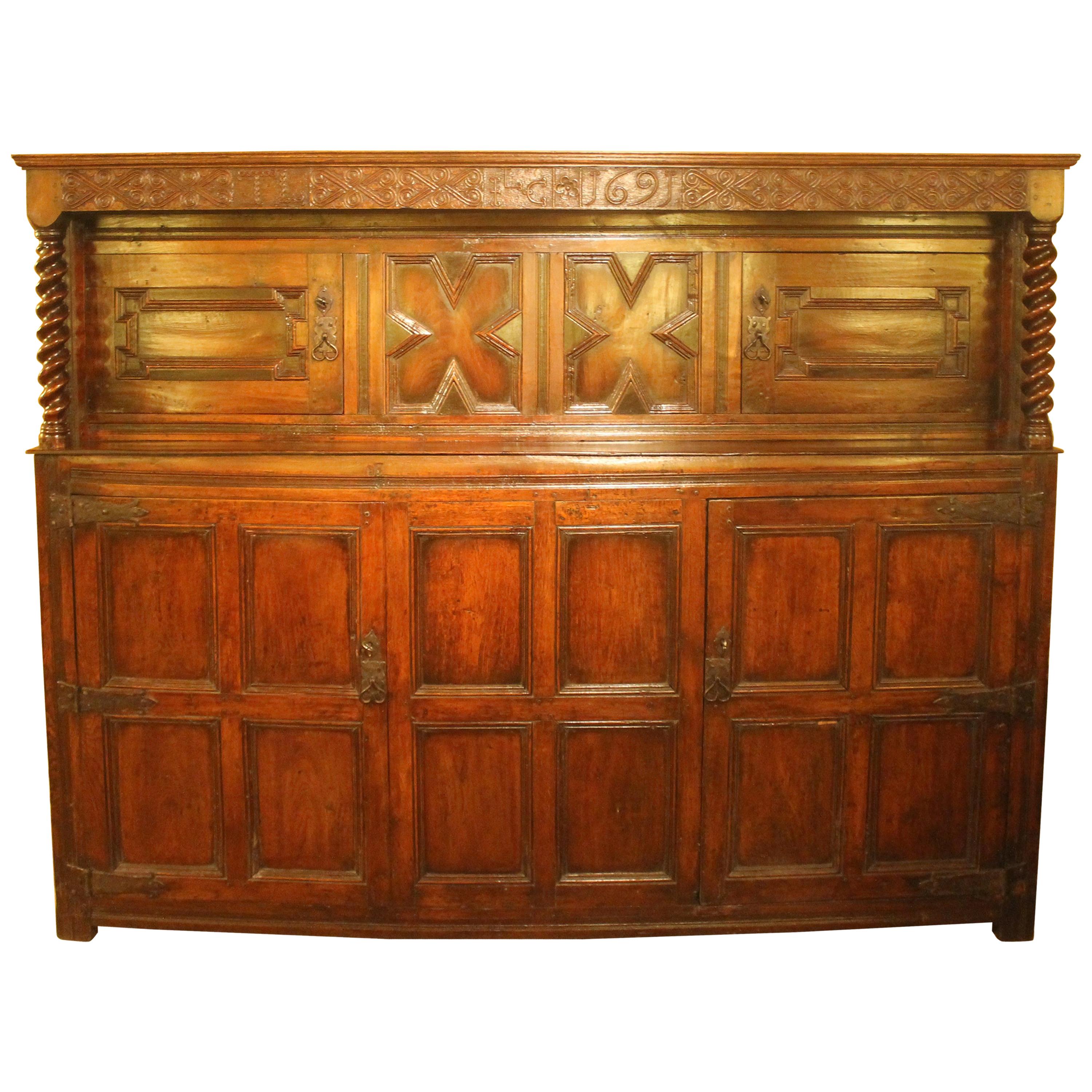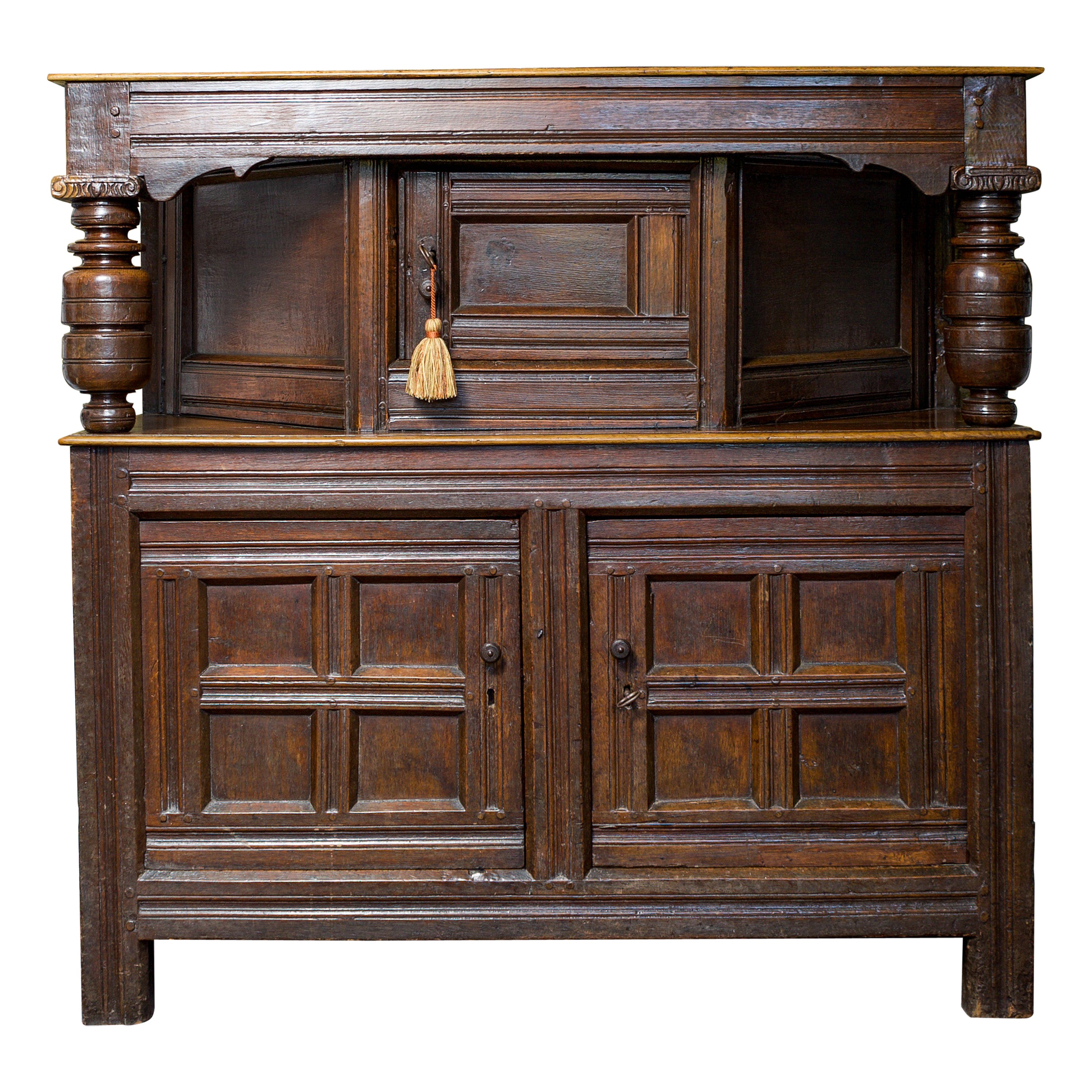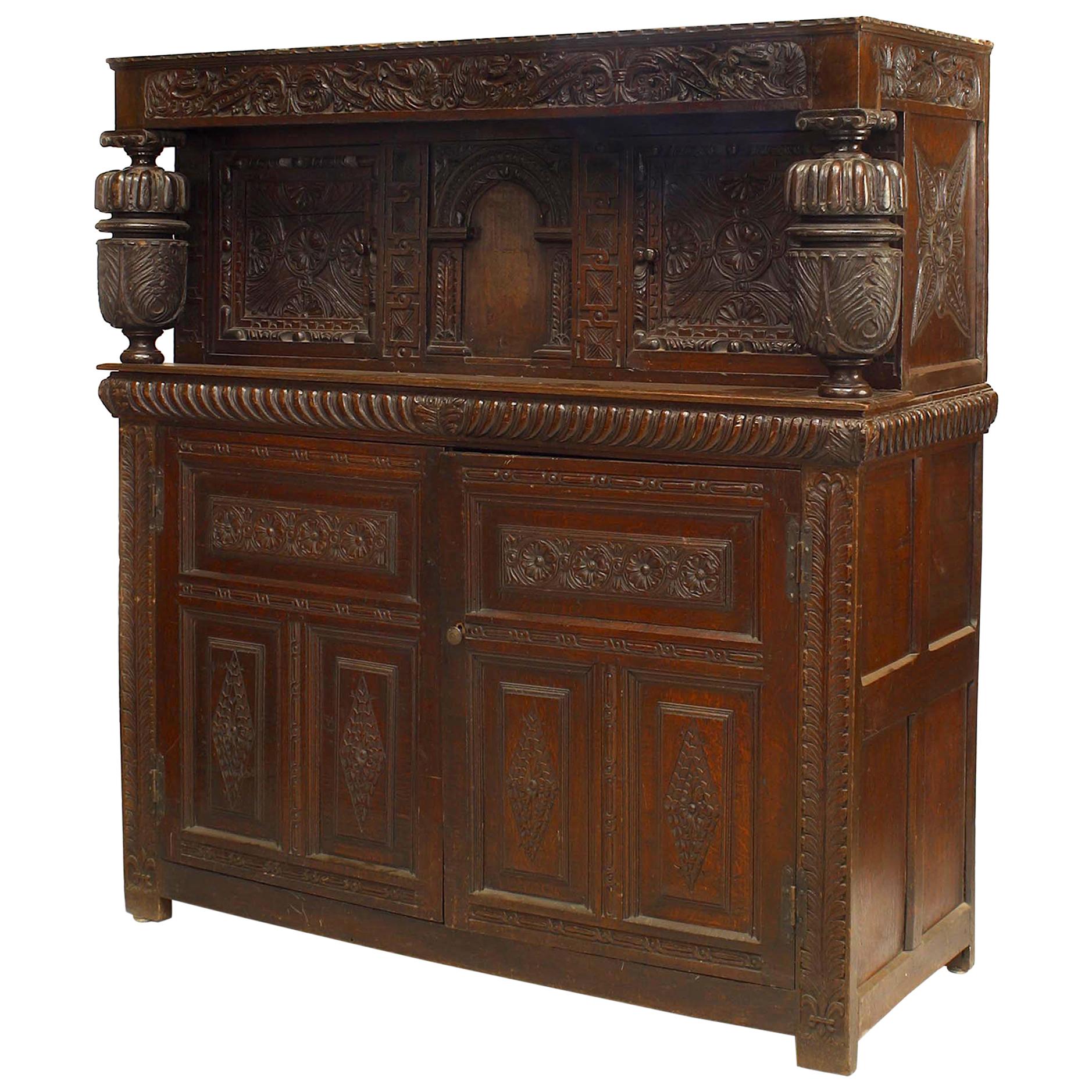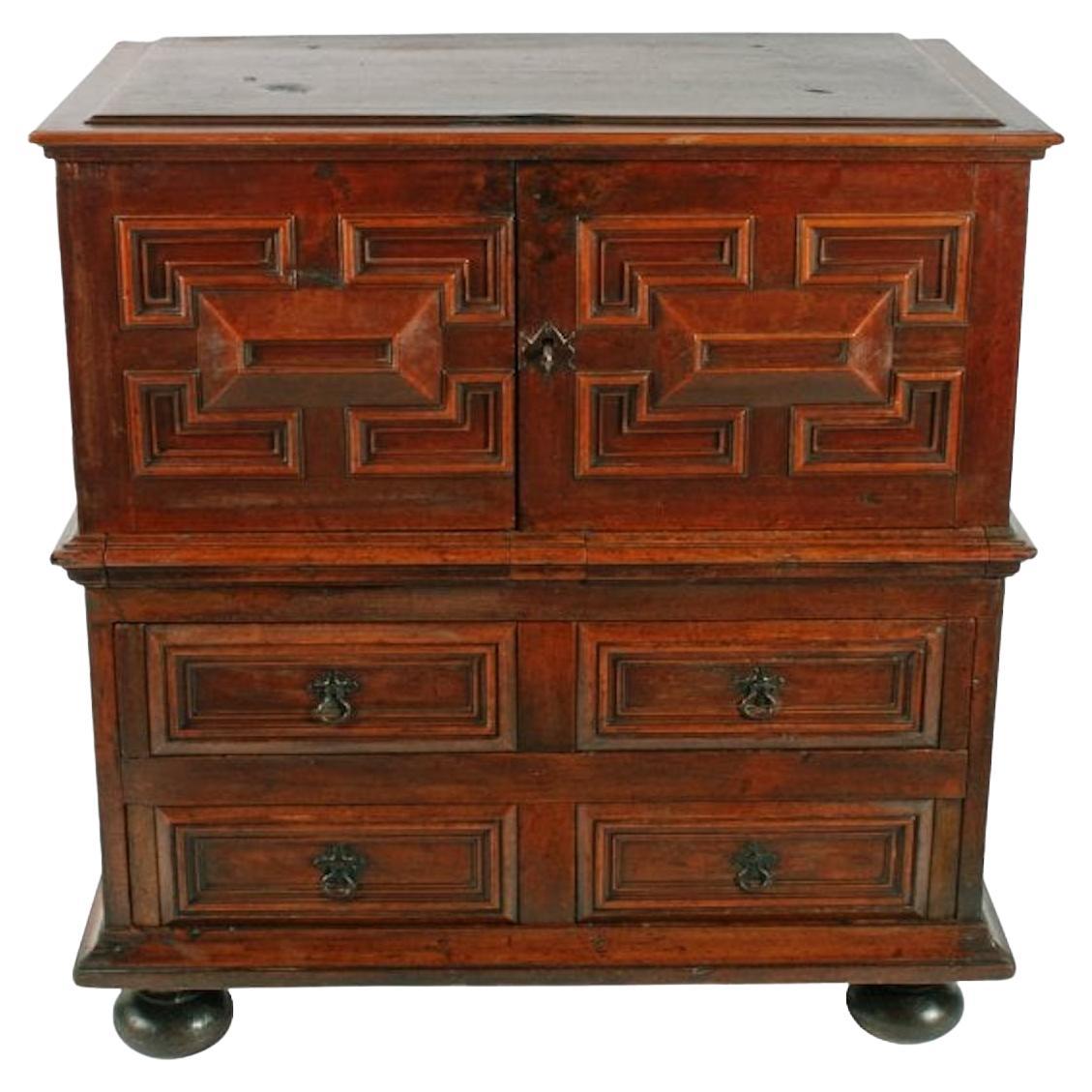Items Similar to 17th Century Charles II English Cupboard Cabinet
Want more images or videos?
Request additional images or videos from the seller
1 of 18
17th Century Charles II English Cupboard Cabinet
About the Item
This is a circa 1660 Charles II English cupboard. This style was characterized by elaborate carvings and large frames. During Charles II's reign, there was a revival in the art and design of furniture-making, despite the challenges that arose from the Great Fire of London in 1666 and the subsequent plague outbreak. This piece has been excellently crafted and carved entirely from oak. Oak was prized for its durability. It is not uncommon to find Charles II English furniture pieces in excellent condition, even centuries after they were made.
Cupboards were popular furniture pieces in the 17th century and were used for the storage of food or linens. The front doors of this cupboard have inset panels with a geometric design of rectangles with linear trim molding around them. Separating the doors is a vertical beaded column molding that adds contrast to the Stark lines of the rectangle designs. By the hinges, there are spherical column moldings that add decoration as well as elongate the look of the cupboard. The two doors swing open to reveal three sturdy shelves and a bottom storage area. Inside the top shelf, you can see that there are original wooden pegs that are meant for hanging items. This historical piece would look great in any room, especially a large bedroom or dining room. Owning a piece of Charles II furniture is a testament to the enduring legacy of British craftsmanship, as well as an opportunity to enjoy the beauty and elegance of furniture from a bygone era.
Cupboard Closed: H= 72 in., W= 48 in., D= 21 in., 300 lbs.
Cupboard Wide Opened: H= 72 in., W= 74 in., D= 38 in., 300 lbs.
Top Shelf space: H = 12 in. W= 45 in. D= 16 in.
Middle Shelf space: H = 13 in. W= 45 in. D= 16 in.
Lower Shelf space: H = 10 in. W= 45 in. D= 16 in.
Inner Bottom storage: H in. 23 in. W= 45 in. D= 16 in.
- Dimensions:Height: 73 in (185.42 cm)Width: 48 in (121.92 cm)Depth: 20.5 in (52.07 cm)
- Style:Charles II (Of the Period)
- Materials and Techniques:
- Place of Origin:
- Period:
- Date of Manufacture:1660
- Condition:Repaired: Everything is handmade, even the nails. There is some separation in the wood due to age. A professional restorer added two wooden brackets to one of the shelves to brace it and fix slight warping (see image). It has been recently waxed. Refinished. Wear consistent with age and use. It has a rich patina, slight nicks, and scratches age, but sturdy. The shelves are removable but it does not disassemble. It is constructed to be moved as one entire piece weighing 300 lbs. Please keep this in mind when picking it up or moving it.
- Seller Location:Chicago, IL
- Reference Number:1stDibs: LU7185234092492
About the Seller
5.0
Vetted Seller
These experienced sellers undergo a comprehensive evaluation by our team of in-house experts.
Established in 1964
1stDibs seller since 2022
6 sales on 1stDibs
Typical response time: 1 hour
- ShippingRetrieving quote...Ships From: Chicago, IL
- Return PolicyA return for this item may be initiated within 14 days of delivery.
More From This SellerView All
- Late 17th Century English Oak DresserLocated in Chicago, ILThe Charles II period design incorporated a French influence. Furniture was often characterized by elegant carvings with a focus on reliability and usefulness. This dresser has been ...Category
Antique 17th Century English Charles II Dressers
MaterialsOak
- Circa 1750, English Georgian ii Period Mahogany Armchair with Modern FabricLocated in Chicago, ILCirca 1750 English Georgian II period mahogany armchair. The George II period was most noted for its intricate chairs. Like the other Georgian periods, this one was named after the monarch during the time. Under George II, mahogany became the predominant wood used for fine furniture. Many of the styles were symmetrical and had architectural curves, inspired by the Gothic. These works were very expensive and only the rich could afford and buy them. This specific armchair has a frame entirely carved from mahogany, which was a strong and durable wood that was also naturally water resistant and offers natural resistance against pests. The back of the chair has a splat design. Splats were an important element of eighteenth-century English chairs, offering support. It originated from the importation of Chinese Ming Dynasty chairs...Category
Antique 1750s English George II Armchairs
MaterialsMahogany
- Early 19th Century English Regency Greek Revival Gilt Carving of a SphinxLocated in Chicago, ILFrom the 1700s through the early 1800s, European aristocrats developed a fascination with ancient Egyptian culture and design that culminated in a full Egyptian Revival. Prominent figures such as Marie Antoinette and Napoleon Bonaparte commissioned rooms decorated with Egyptian motifs. This cultural moment reflects a fascination with a sophisticated civilization of great artists and pharaohs. The Regency era possessed very little knowledge of the Great Pyramids or hieroglyphics, a quality that lent Egyptian art interpretation a compelling air of mystique. This English Regency period gilt carving depicts a popular figure of borrowed Egyptian motif: the Sphinx. Recognized among educated circles as a symbol of brilliance in the ancient past, the Sphinx was well-known as a mythological creature who destroys those who failed to answer her riddle. Such a piece as this, excellent in detail and craftsmanship, may have once graced the mantle of a gentleman’s study or been exchanged as a gift between British scholars. The beautiful gold surface has been achieved by an artful combination of gilt and gesso; the art enthusiast will appreciate the intricate texture realized in the carving’s hair and tail as well as the delicate detailing of the saddle. Borrowing from the Egyptians, the Greeks had their own interpretation of the Sphinx. Greek mythology chronicled the Sphinx as being the daughter of Orthous and Chimera or Laius and attributed the riddles, which she proposed, as having been taught to her by the Muses. Crowned with a Grecian diadem and having a refined expression, she evokes an ancient yet reserved intellect. For the modern-day enthusiast of classical Greek art...Category
Antique Early 19th Century English Regency Figurative Sculptures
MaterialsGold Leaf
- 18th Century English George III Period Mahogany Armchair with Modern FabricLocated in Chicago, ILThis is a finely carved 1760 English George III armchair. The George III period was named after the English monarch of the time. It was popular among the elite and mercantile class of people, due to its excellent material and intricate carvings. Due to the multiple King Georges, each George developed its own look. The George III period is also referred to as the Chippendale style. This period was often characterized by drawing on both the Rococo and Gothic styles. Pieces sported curves, arches, Chinese influences, and cabriole legs. This chair has been entirely carved out of mahogany; a premiere wood choice known for its durability, longevity, and rich coloring. The back has an elegant splat, a principal element of eighteenth-century English chairs. Splats are the center support for a chair’s open back and originated from the importation of Chinese Ming Dynasty chairs...Category
Antique 1760s English George III Armchairs
MaterialsMahogany
- Early 19th Century English Regency Mahogany Tub Chair ArmchairBy George SmithLocated in Chicago, ILarly 19th Century English Regency mahogany armchair in the Manner of George Smith (Born in 1786). George Smith was a celebrated furniture designer during the Regency Period. His desi...Category
Antique Early 19th Century English Regency Armchairs
MaterialsMahogany
- Early 19th Century Austrian Hiking StaffLocated in Chicago, ILThis one-of-a-kind Austrian hiking staff has been handcrafted from solid oak. Oak is a relatively lightweight yet sturdy material, which lends itself perf...Category
Antique Early 19th Century Austrian Folk Art Sculptures and Carvings
MaterialsSilver, Brass
You May Also Like
- 17th Century English Oak CupboardLocated in Mt Kisco, NY17th century English oak cupboard. The cupboard has a dark stained oak patina with a raised panel design on each side. The cupboard doors ...Category
Antique Late 17th Century Welsh Charles II Cupboards
MaterialsOak
- 17th Century English Cupboard Period James IILocated in Brussels, Brusselsexceptional 17th century English buffet dated 1691 in oak from Scotland Rare sideboard James II period with very beautiful original irons This piece of furniture stands out by his...Category
Antique 17th Century French James II Wardrobes and Armoires
MaterialsOak
- 17th Century, Charles II, Canted Oak Livery Cupboard, England, Circa 1660Located in Leominster, GB17th century canted oak livery cupboard, with plain cup & cover supports with ionic capitals.Category
Antique 17th Century British Charles II Cupboards
MaterialsOak
- English Charles I 17th Century Oak and Inlaid Court CupboardLocated in Troy, NYLarge English Charles I Oak and Inlaid Court Cupboard, Yorkshire circa 1640, having a boarded top with a delicately carved edge above a leave-carved frie...Category
Antique 1640s English Jacobean Cupboards
MaterialsWood
- English Charles II Style Oak CupboardLocated in New York, NYEnglish Charles II-style (17th Century and Later) oak court cupboard of paneled construction with a Pair of doors behind baluster uprights over another Pair of doorsCategory
Antique 19th Century English Charles II Cupboards
MaterialsOak
- Charles II Cedar Wood Chest, 17th CenturyLocated in Southall, GBCharles II Cedar Wood chest A 17th century Charles II cedar wood cushion fronted chest. The chest is smaller than usual and comes in two parts, the two door cupboard top has be...Category
Antique 17th Century English Cupboards
MaterialsCedar
Recently Viewed
View AllMore Ways To Browse
Antique Wooden Bedroom Cupboard
Antique French Panettiere
French Panettiere
Antique Shaker Cupboard
Beadboard Cupboard
Hoosier Cupboard
House Keepers Cupboard
Antique Cupboard Hoosier
Antique Oak Court Cupboard 20th Century
Cylindrical Pot Cupboard
Pennsylvania Dutch Cabinet
Walnut Pie Safe
White Housekeeper Cabinet
White Housekeeper Cupboard
Painted Marriage Cupboard
Breton Cupboard
Vintage Food Cupboard
18th Century Primitive Cupboard
